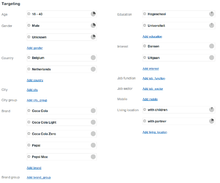Targeted advertising

Targeted advertising is a type of advertising whereby advertisements are placed so as to reach consumers based on various traits such as demographics, psychographics, behavioral variables (such as product purchase history), and firmographics ... or other second-order activities which serve as a proxy for these traits.[1]
Most targeted new media advertising currently uses second-order proxies for targeting, such as tracking online or mobile web activities of consumers, associating historical webpage consumer demographics with new consumer web page access, using a search word as the basis for implied interest, or contextual advertising.[2]
Addressable advertising systems serve ads directly based on demographic, psychographic, or behavioral attributes associated with the consumer(s) exposed to the ad. These systems are always digital and must be addressable in that the end point which serves the ad (set-top box, website, or digital sign) must be capable of rendering an ad independently of any other end points based on consumer attributes specific to that end point at the time the ad is served. Addressable advertising systems therefore must use consumer traits associated with the end points as the basis for selecting and serving ads.[3]
The process
Advertisers want to reach as many consumers as efficiently as possible. This requires an understanding of how customers' minds work.[4]
Behavioral targeting is the most common targeting method used online. Behavioral targeting works by anonymously monitoring and tracking the content read and sites visited by a user or IP when that user surfs on the Internet. This is done by serving tracking codes. Sites visited, content viewed, and length of visit are databased to predict an online behavioral pattern.[5] A further refinement to behavioral targeting is Predictive Behavioral Targeting, where machine learning algorithms overlay behavioral patterns with sampled data, to create data-rich predicted profiles for every user.
Alternatives to behavioral advertising include audience targeting, contextual targeting, and psychographic[6] targeting.
Effectiveness
The Network Advertising Initiative conducted a study[7] in 2009 measuring the pricing and effectiveness of targeted advertising. It revealed that targeted advertising:
- Secured an average of 2.7 times as much revenue per ad as non-targeted "run of network" advertising.
- Twice as effective at converting users who click on the ads into buyers
One of the major difficulties in measuring the economic efficiency of targeting, however, is being able to observe what would have happened in the absence of targeting since the users targeted by advertisers are more likely to convert than the general population. Farahat and Bailey [8] exploit a large-scale natural experiment on Yahoo! allowing them to measure the true economic impact of targeted advertising on brand searches and clicks. They find, assuming the cost per 1000 ad impressions (CPM) is $1, that:
- The marginal cost of a brand-related search resulting from ads is $15.65 per search, but is only $1.69 per search from a targeted campaign.
- The marginal cost of a click is 72 cents, but only 16 cents from a targeted campaign.
- The variation in CTR lifts from targeted advertising campaigns is mostly determined by pre-existing brand interest.
Benefits
- For the consumer : Because behavioral marketing enables advertisers to more easily determine user preferences and purchasing habits, the ads will more pertinent and useful for the consumers.
- For the advertiser: With targeted advertising, firms advertise more to consumers who have a strong preference for their product. It allows the firm to eliminate “wasted” advertising to consumers whose preferences do not match a product’s attributes. As a result, the targeting of advertising leads to higher profits.[9]
Controversies
Targeted Advertising has raised a lot of fear and controversies, most particularly towards the privacy rights and policies.
Privacy International is fighting in order to make Governments legislate in a way that protects the rights of the general public. According to them, from any ethical standpoint such interception of web traffic must be conditional on the basis of explicit and informed consent. And action must be taken where organisations can be shown to have acted unlawfully.[10]
A survey conducted in the United States by the Pew Internet & American Life Project between January 20 and February 19, 2012 revealed that most of Americans are not in favor of targeted advertising, seeing it as an invasion of privacy. Indeed 68% of those surveyed said they are "not okay" with targeted advertising because they do not like having their online behavior tracked and analyzed.[11]
References
- ↑ http://www.engadget.com/2011/01/28/google-testing-display-ads-in-gmail-our-patience/ Google testing display ads in Gmail, our patience
- ↑ http://www.engadget.com/2013/07/22/gmail-email-ads/ New Gmail layout spawns targeted ads that look like emails
- ↑ http://www.engadget.com/2014/01/15/sky-adsmart-targeted-advertising/ Sky's AdSmart brings targeted advertising to your TV
- ↑ Panella, Roger (18 October 2012). "Targeted Advertising: How User Intent Will Help You Choose Keywords That Convert". Retrieved 18 January 2013.
- ↑ "What is targeted advertising?". Discovery Communications. Retrieved 7 November 2013.
- ↑ Smith, Samuel J (2013). Psychographic Targeting and Message Customization in Online Advertising (M.A. thesis).
- ↑ http://www.networkadvertising.org/pdfs/Beales_NAI_Study.pdf
- ↑ Farahat, Ayman; Michael Bailey (16 April 2012). "How Effective is Targeted Advertising?". Retrieved 7 November 2013.
- ↑ Iyer, Ganesh; David Soberman; J Miguel Villa-Boas (Summer 2005). "The Targeting of Advertising". INFORMS. pp. 461–476. Retrieved 7 November 2013.
- ↑ https://www.privacyinternational.org/article/online-behavioural-targeted-advertising-%E2%80%93-privacy-international%E2%80%99s-position
- ↑ http://news.yahoo.com/americans-not-fans-online-targeted-ads-survey-201105738.html